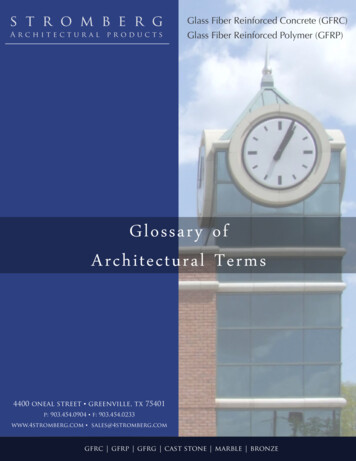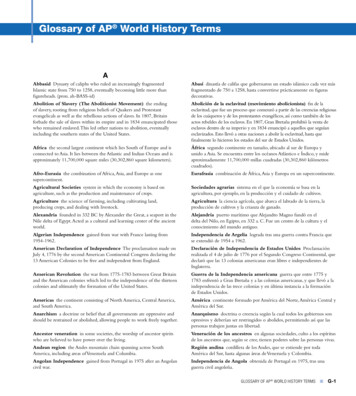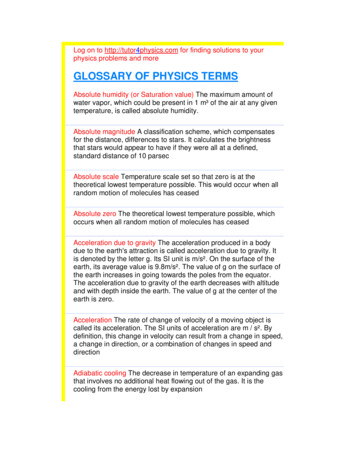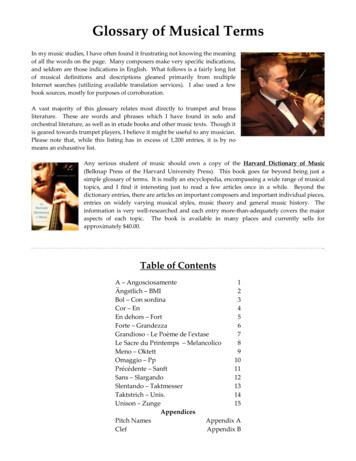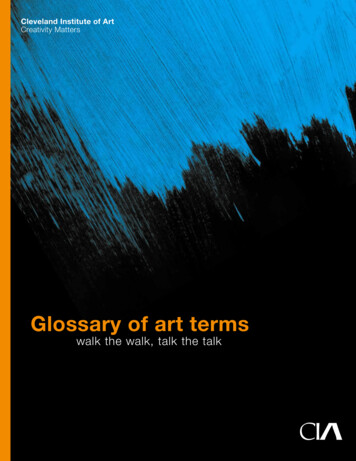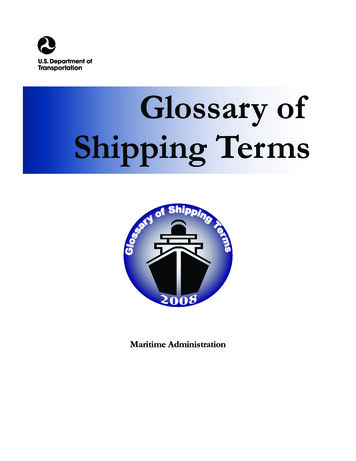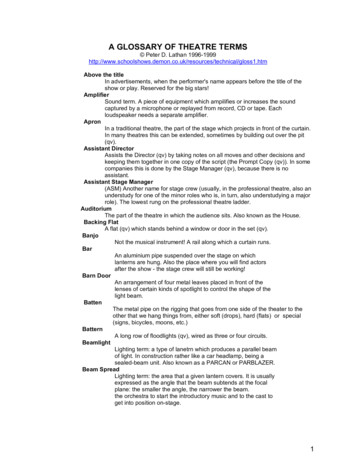
Transcription
A GLOSSARY OF THEATRE TERMS Peter D. Lathan ces/technical/gloss1.htmAbove the titleIn advertisements, when the performer's name appears before the title of theshow or play. Reserved for the big stars!AmplifierSound term. A piece of equipment which ampilifies or increases the soundcaptured by a microphone or replayed from record, CD or tape. Eachloudspeaker needs a separate amplifier.ApronIn a traditional theatre, the part of the stage which projects in front of the curtain.In many theatres this can be extended, sometimes by building out over the pit(qv).Assistant DirectorAssists the Director (qv) by taking notes on all moves and other decisions andkeeping them together in one copy of the script (the Prompt Copy (qv)). In somecompanies this is done by the Stage Manager (qv), because there is noassistant.Assistant Stage Manager(ASM) Another name for stage crew (usually, in the professional theatre, also anunderstudy for one of the minor roles who is, in turn, also understudying a majorrole). The lowest rung on the professional theatre ladder.AuditoriumThe part of the theatre in which the audience sits. Also known as the House.Backing FlatA flat (qv) which stands behind a window or door in the set (qv).BanjoNot the musical instrument! A rail along which a curtain runs.BarAn aluminium pipe suspended over the stage on whichlanterns are hung. Also the place where you will find actorsafter the show - the stage crew will still be working!Barn DoorAn arrangement of four metal leaves placed in front of thelenses of certain kinds of spotlight to control the shape of thelight beam.BattenThe metal pipe on the rigging that goes from one side of the theater to theother that we hang things from, either soft (drops), hard (flats) or special(signs, bicycles, moons, etc.)BatternA long row of floodlights (qv), wired as three or four circuits.BeamlightLighting term: a type of lanetrn which produces a parallel beamof light. In construction rather like a car headlamp, being asealed-beam unit. Also known as a PARCAN or PARBLAZER.Beam SpreadLighting term: the area that a given lantern covers. It is usuallyexpressed as the angle that the beam subtends at the focalplane: the smaller the angle, the narrower the beam.the orchestra to start the introductory music and to the cast toget into position on-stage.1
A GLOSSARY OF THEATRE TERMS Peter D. Lathan ces/technical/gloss1.htmBeginnersThose members of the cast who are on-stage when the curtaingoes up. The call (qv) "Overture and beginners" is a signal toBlackoutLighting term: switching all lights out at once, leaving thestage in complete darkness. See also DBO.BlacklightUltra-violet light. Can be in bulb or, more usually, tube form.BlacksBlack curtains at the back and sides of the stage.BlockingThe setting of the actors' positions and moves at the beginningof rehearsals. Occasionally known as plotting, but this term isusually reserved for use in lighting.BoardAnother name for a control desk, either lighting (most usually)or sound.Book (The)A copy of the script, kept by the Stage Manager, whichincludes all cues (qv) and notes. Also known, usually inamateur theatre, as the "prompt copy."Box OfficeThe place where the tickets are sold. Also used colloquially tomean the size of the audience ("What's the box office liketonight?")Box SetA set (qv) which consists of three walls, around a prosceniumarch (qv) stage. The proscenium opening is the fourth wall.Also known as a "room set".CallGenerally, some sort of instruction to the company: arehearsal call is an instruction to attend a rehearsal at aparticular time; time calls are given just before eachperformance ("Ladies and gentlemen, this is your thirty minutecall"); treasury call is pay day in the professional theatre. Notethat time calls are all related to the "Beginniners" call, not tothe actual time of starting the show. In other words, the 30minute call is given 30 minutes before "Orchestra &Beginners" is called, or 35 minutes before the curtain goes up.CansHeadphonesCastThe list of characters in a play and the actors who play them.Also, as a verb, to allocate parts to members of a company.CheatTo make an action on stage look realistic without actuallydoing what you seem to be doing; e.g. an actor lookingtowards the audience in the general direction of the person heis talking to, is cheating.CheckLighting term: to lower the brightness of a lantern (qv) to zero.2
A GLOSSARY OF THEATRE TERMS Peter D. Lathan ces/technical/gloss1.htmChief Electrician(Usually abbreviated to Chief LX) He is head of the departmentwhich is responsible for the maintenance and rigging of thelighting, and the operation of the lighting plot. In act, he isusually responsible for the maintenance and repair of anythingelectrical in the theatre, from the stage lighting to the light inthe gent's toilet! His crew are variously known as LX, electricaldaymen, electrics crew, etc.ChoreographerDevises and rehearses the dance routines, following theconcept laid down by the Director (qv).CinemoidA (now discontinued) brand name for a lighting gel or filter. Stillused by old-timers (like me!) generically.ClothBackdrop scenery painted on fabric. Cloths can be on a banjo(usually in the amateur theatre), can be rolled up, or can beflown (qv).Colour ChangerA remotely controlled means of changing a coloured filter overthe lens of a lantern. There are three kinds: a wheel, asemaphore (like the old- fashioned railway signals) and ascroller which uses continuous, usually dichroic, filters.Scrollers are the preferred option in the modern theatre.Colour FrameA frame which fits over the front of a lantern to held a colouredfilter or gel. They can be made from metal (preferred) or a kindof cardboard.Come downIn the theatre, a show does not finish; it comes down, i.e. thecurtain "comes down" to end the show.Company ManagerThe person in charge of a touring company when it is on theroad.CornerShort for the "prompt corner"; the place from which the StageManager controls the show. From here he has communicationlinks to all parts of the the theatre and gives cues (qv) to alldepartments. The corner can be on either side of the stage buttraditionally it is on the left (i.e. the prompt) side. Perverselysome theatres have the prompt corner on the "oppositeprompt" (OP) side of the stage! The person who is operatingthe corner is sometimes said to be "in the corner" andsometimes "on the book".CorpseNot a dead body in a thriller! An actor who gets an unintendedand uncontrollable fit of laughter on stage is said to "corpse".Cross FadeLighting term: fading one lantern (or group of lanterns) up whilefading another down.3
A GLOSSARY OF THEATRE TERMS Peter D. Lathan ces/technical/gloss1.htmCSICompact Source Iodide: a type of discharge lamp, usuallyused in follow-spots, which, although very small (often nobigger than a finger nail), gives a very bright, white light. A 2KCSI lamp will give the same power as a 5K tungsten. Theseare, needless to say, very expensive.CueAn instruction given by the Stage Manager to one of thetechnical departments to take some action; e.g. LX cue 7 isthe seventh instruction in the play to the lighting department.Also used in the sense of the point at which an actor mustenter or speak.Curtain CallTaking a bow in front of the audience at the end of a show.Usually abbreviated to "curtain".Cut-outA free-standing piece of scenery, e.g.a tree, cut out of boardinto the correct shape and painted.CycloramaAlso known as a cyc. A very large piece of white fabric,tensioned on two or more sides, which covers the entire backwall of the stage. It can be lit in various colours or have slidesor gobos projected onto it.DATSound recording term: digital audio tape. A very high qualityaudio recording method in which sound is digitally recorded ontape (often video S-VHS tapes are used).DBOLighting term. Dead blackout: a sudden, instantaneousswitching off of all lights.DSLDown stage left: towards the front of the stage on the left-handside as you look at the audience.DSRDown stage right.Deputy Stage Manager(DSM) The deputy to the Stage Manager (qv). He usually runsthe corner (qv) and is therefore responsible for the minute byminute running of the show.DesignerDesigns all aspects of the production: set, costumes, wigs,make-up etc. Not, however, responsible for lighting design,although he will work closely with the Lighting Designer (qv).DeskSee "Board"DieA production is said to die if it fails to please the public and so istaken off. In the much less polite circles of the variety world, ashow or act which fails to draw applause is said to "die on itsarse".4
A GLOSSARY OF THEATRE TERMS Peter D. Lathan ces/technical/gloss1.htmDimmerA piece of equipment for varying the amount of electricity sent toa lantern, thus varying its brightness. Sometimes (inaccurately)used for the fader which controls the dimmer. Originally dimmerswere variable resistors but now are either thyristors or triacs, i.e.they work electronically rather than by physically moving aresistor along a coil of wire. The verb "to dim" can be used tomean increase ("dim up") or reduce ("dim down") the amount oflight, or even switch it off entirely ("dim out").DipsElectrical socks set into the floor of either the stage or the wings(qv), and, usually, covered by little trapdoors.DirectorIn control of all aspects of the production.(S)he develops theconcept of the production, briefs the designer and lightingdesigner, plots the actor's moves, rehearses the actors, etc. etc.etc.DoublingOne actor taking more than one part in a play.DownstageTowards the audience.DresserOne whose job it is to help an actor (or actors) in quick changesof costume.DryVerb: an actor who forgets his words is said to "dry". Can alsobe used as a noun.Effects SpotA spotlight (qv) which projects a slide, or a still or movingpicture, i.e. of rain or clouds, onto the stage or, more usually,the cyclorama.FadeSound and lighting term: to increase (fade up), decrease (fadedown) or eliminate (fade out) gradually the brightness of a lanternor the volume of a sound.Fit upNot something done by the police (allegedly!), but actuallybuilding up the set (qv) on-stage.FlatAn oblong frame of timber, covered with either canvas orhardboard and painted, which forms part of the set. There arealso door flats, window flates, even fireplace flats. Canvas flats,being lighter and easier to move around, are the preferred option,but schools often go for hardboard-covered flats which are morehardwearing.FloatsA rather old-fashioned term for Footlights (qv).5
A GLOSSARY OF THEATRE TERMS Peter D. Lathan ces/technical/gloss1.htmFloodA floodlight: a lantern which gives a wide-spreading, unfocusedbeam of light. These can be symmetric (i.e. casting the lightequally in all directions) or asymmetric (casting it more in onedirection than the others). The symmetric flood is probably thecheapest stage lantern - and the least useful!FlyVerb: scenery which is raised into the roof (flown out) or loweredon the stage (flown in). The apparatus for doing this consists of aseries of ropes and pulleys in the "fly tower" (a very high roofspace) and they raise or lower the scenery by means of acounterweight system or by directly pulling on "hemp lines". Themen who operate the "flies" are called "flymen" and the area inwhich they work is called the "fly floor" of, quite simply, the"flies". People can also be flown (as in every production of "PeterPan"!) in a harness.FocusVerb used in lighting: to point the lanterns (qv) in the rightdirection and set the correct beam-spread and edge.FoHFront of House: anything which happens on the audience side ofthe curtain is said to happen "front of house". The term "thehouse" is used to mean either the auditorium, or the audience("We had a good house tonight"), or even the theatre itself. TheRoyal Opera House, Covent Garden, is also known as "TheHouse" (with capital letters, of course!).Follow-spotA type of profile (qv) spotlight (qv) with an irs diaphragm and ahandle so that it can be used to follow a performer around thestage in a beam of light of exactly the right size. Traditionallycalled a "lime": hence the term "being in the limelight". Theseproduce a very bright beam of light which is more powerful thanthat produced by any other lanterns. Modern limes almostalways use CSI lamps (qv).FootlightsA series of floodlights (qv) placed on the stage floor along thefront of the stage. Traditional in variety theatres, foots arenowadays rarely used.FresnelA kind of spotlight (qv) in which the light is concentrated by afresnel lens (a lens with concentric ridged rings). Projects avariable angle soft-edged beam. Sometimes called a frênel andgiven the French pronunciation.FXEffects: usually sound effects in the theatre but can also refer topyrotchnics (qv). In film, usually refers to visual (i.e. computergenerated) effects.GateThe focal plane of a profile spot (qv) into which gobos (qv) and irisdiaphragms can be placed.6
A GLOSSARY OF THEATRE TERMS Peter D. Lathan ces/technical/gloss1.htmGauzeA loosely-woven cloth (qv) on which a scene can be painted. When litfrom the front, it is opaque and only the painted scene is seen; when litfrom behind, however, it becomes transparent. Commonly used inpantomime.G-clampUsed for fastening lanterns to a bar. A G-shaped piece of metal with ascrew throught the bar of the G which clamps to the lighting bar.GelA filter placed over the front of a lantern to change the colour of the light.Get Out(Not what the director says when he fires you. Well, not only that!) Atouring theatre term: "getting out" the scenery, props
Not the musical instrument! A rail along which a curtain runs. Bar An aluminium pipe suspended over the stage on which lanterns are hung. Also the place where you will find actors after the show - the stage crew will still be working! Barn Door An arrangement of four metal leaves placed in front of the lenses of certain kinds of spotlight to control the shape of the light beam. Batten The .

